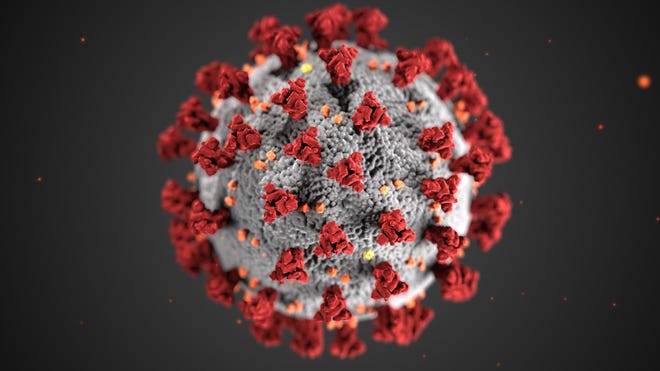See signs, circumstances, newest CDC knowledge
The KP.3.1.1 COVID-19 variant is the dominant pressure of the virus, the most recent projections from the Facilities for Illness Management and Prevention (CDC) present.
The company’s Nowcast knowledge tracker, which shows COVID-19 estimates and projections for two-week durations, initiatives the KP.3.1.1 variant is accounting for 36.8% of optimistic infections, adopted by KP.3 at 16.8% within the two-week stretch beginning Aug. 4.
“The KP.3.1.1 variant is similar to different circulating variants in the US. All present lineages are descendants of JN.1, which emerged in late 2023,” Rosa Norman, a spokesperson on the CDC, beforehand advised USA TODAY.
“Presently, we anticipate that COVID-19 remedies and vaccines will proceed to work in opposition to all circulating variants,’ she mentioned. “CDC will proceed to observe the severity of variants and can monitor vaccine effectiveness.”
Beforehand, the KP.3.1.1 variant made up 22.8% of circumstances for the two-week interval ending on Aug. 3 and KP.3 accounted for 21.0%. Based on the information, KP.3.1.1 rose 14% and KP.3 decreased 4.2% from Aug. 3 in projected optimistic infections.
Here’s what you’ll want to know in regards to the KP.3.1.1 variant.
See newest knowledge:CDC says COVID is at ‘very excessive’ exercise ranges in some US states
How are KP.3 and KP.3.1.1 variants related?
Based on the CDC’s Nowcast knowledge, the KP.3.1.1 COVID-19 variant was essentially the most prevalent pressure on the nationwide, regional, and state ranges for the week ending Aug. 17.
“KP.3.1.1 is a sub-lineage of KP.3,” Norman mentioned.

How are KP.3 and KP.3.1.1 completely different?
Norman beforehand defined that KP.3.1.1 has one change in spike protein.
JN.1, a variant that has been circulating since December 2023, solely noticed a single change in spike, not like the KP.3 variant, which is a sub-lineage of the JN.1, Dave Daigle, a spokesperson on the CDC, beforehand advised USA TODAY.
“KP.3.1.1 has one change within the spike protein compared to KP.3,” Norman mentioned.
CDC studies:Recalled cucumbers in salmonella outbreak sickened 449 individuals in 31 states
COVID-19 Present Wastewater Viral Exercise Ranges Map
CDC knowledge exhibits that over half of the US have reported “very excessive” ranges of COVID-19 exercise.
Utilizing wastewater or sewage, the CDC checks the water to see if there are any traces of an infectious illness inside a group, the federal government company says.
Knowledge collected on Aug. 9 by the CDC confirmed that 27 states have reported “very excessive” ranges of wastewater viral exercise nationwide.
Here’s a map of the states and territories which have reported wastewater viral exercise ranges as of Aug. 9:
Cannot see the map? Click on right here to view it.
Modifications in COVID-19 check positivity inside per week
Knowledge collected by the CDC exhibits that six Midwestern states making up Area 5 had the largest improve (2.1%) in optimistic COVID-19 circumstances from July 28 to Aug. 3, 2024. The info was posted on Aug. 12, 2024.
Word: The CDC organizes positivity charge based mostly on areas, as outlined by the U.S. Division of Well being and Human Providers.
This is the checklist of states and their areas’ adjustments in COVID-19 positivity for the previous week:
- Area 1 (Connecticut, Maine, Massachusetts, New Hampshire, Rhode Island, and Vermont): +1.4%
- Area 2 (New Jersey, New York, Puerto Rico, and the Virgin Islands): -1.3%
- Area 3 (Delaware, District of Columbia, Maryland, Pennsylvania, Virginia, and West Virginia): +1.3%
- Area 4 (Alabama, Florida, Georgia, Kentucky, Mississippi, North Carolina, South Carolina, and Tennessee): +1.4%
- Area 5 (Illinois, Indiana, Michigan, Minnesota, Ohio, and Wisconsin): +2.1%
- Area 6 (Arkansas, Louisiana, New Mexico, Oklahoma, and Texas): +1.5%
- Area 7 (Iowa, Kansas, Missouri, and Nebraska): +0.9%
- Area 8 (Colorado, Montana, North Dakota, South Dakota, Utah, and Wyoming): -1.2%
- Area 9 (Arizona, California, Hawaii, Nevada, American Samoa, Commonwealth of the Northern Mariana Islands, Federated States of Micronesia, Guam, Marshall Islands, and Republic of Palau): -3.1%
- Area 10 (Alaska, Idaho, Oregon, and Washington): +1.2%

COVID-19 signs
The CDC has not mentioned if KP.3 or KP.3.1.1 have their very own particular signs. Nevertheless, Norman beforehand defined that the signs related to KP.3 are just like these from JN.1. The federal government company outlines the essential signs of COVID-19 on its web site. These signs can seem between two and 14 days after publicity to the virus and may vary from delicate to extreme.
These are a few of the signs of COVID-19:
- Fever or chills
- Cough
- Shortness of breath or issue respiration
- Fatigue
- Muscle or physique aches
- Headache
- Lack of style or scent
- Sore throat
- Congestion or runny nostril
- Nausea or vomiting
- Diarrhea
The CDC mentioned it’s best to search medical consideration if in case you have the next signs:
- Bother respiration
- Persistent ache or strain within the chest
- New confusion
- Incapability to wake or keep awake
- Pale, grey, or blue-colored pores and skin, lips, or nail beds
How can we shield ourselves from KP.3, KP.3.1.1, and different variants?
The CDC recommends that everybody 6 months previous and older get the up to date 2024-2025 COVID-19 vaccine. Norman additionally recommends that the aged and those that are immunocompromised ought to get vaccinated with the intention to shield themselves from COVID-19.
Ahjané Forbes is a reporter on the Nationwide Trending Crew at USA TODAY. Ahjané covers breaking information, automobile recollects, crime, well being, lottery and public coverage tales. Electronic mail her at aforbes@gannett.com. Observe her on Instagram, Threads and X (Twitter) @forbesfineest.
